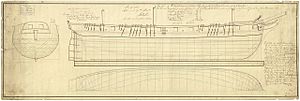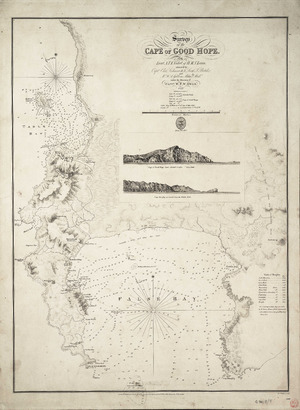HMS Leven (1813) facts for kids

Leven
|
|
Quick facts for kids History |
|
|---|---|
| Name | HMS Leven |
| Ordered | 18 November 1812 |
| Builder | Jabez Bayley, Ipswich |
| Laid down | March 1813 |
| Launched | 23 December 1813 |
| Completed | By 5 March 1814 for ordinary |
| Reclassified | Hospital ship 1827, prison hulk 1830, receiving ship 1842 |
| Fate | Broken-up, July 1848 |
| General characteristics | |
| Class and type | Cyrus-class post ship |
| Tons burthen | 45677⁄94 (bm) |
| Length |
|
| Beam | 29 ft 8+3⁄8 in (9.1 m) |
| Sail plan | Full-rigged ship |
| Complement | 135 |
| Armament | 20 x 32-pounder carronades + 2 × 6-pounder chase guns |
HMS Leven was a 20-gun post ship of the Royal Navy. A post ship was a type of warship, smaller than a frigate. Leven was part of the Cyrus class of ships. It was built in Ipswich, England, and launched on December 23, 1813.
The ship became famous for its important work as a survey ship. From 1821 to 1826, it mapped huge parts of the coast of Africa. This journey was led by Captain William Fitzwilliam Owen. Today, Leven Point near Cape Vidal in KwaZulu-Natal, South Africa, is named after this ship.
Early Service: Napoleonic Wars
After it was ready for duty in October 1814, HMS Leven was sent to the coast of La Vendee. This was a region in France. The ship served there during Napoleon Bonaparte's final military campaign. This period was known as the Hundred Days. Captain Buckland Stirling Bluett was in command of Leven at this time.
Mapping the World: Survey Service
In 1816, Leven was taken out of service at Chatham. In August 1818, it was given a new job. It joined the Royal Navy's Survey Service. This service is responsible for mapping oceans and coasts.
Captain David Ewen Bartholomew took command. He set off to map parts of the west African coast and the Cape Verde Islands. Sadly, Captain Bartholomew died in February 1821. His first officer, Robert Baldey, brought Leven back to England. They had tried to map the River Gambia, but it was not successful.
Command of the ship then went to Captain William Fitzwilliam Owen. He was well-known for his mapping work in the Great Lakes. In August 1821, Leven sailed for Africa again. It was joined by a smaller ship called Barracouta. Their orders were to map the coast starting from the Cape of Good Hope.
Later, their mission was expanded. They had to survey the entire east coast of Africa. They also mapped southern Arabia, Madagascar, and several islands in the Indian Ocean. On their way back, they mapped long parts of the west African coast. They also surveyed the River Gambia. During this time, they captured several ships involved in the slave trade. They also helped British forces in the First Anglo-Ashanti War.
By the time Leven returned home in late 1826, it had completed an amazing task. The crew had mapped 30,000 nautical miles (about 55,560 kilometers) of coastline. They also created 83 detailed maps. This was a huge achievement, but it came at a great cost. Half of the crew members on both ships died from tropical diseases during the long journey.
In June 1823, a report from the Cape of Good Hope told an interesting story. Leven found a ship called Singapore near Delagoa Bay. The ship was in the hands of the Portuguese government. Only one crew member was still alive; the captain and all others had died from sickness. The government had taken the ship's cargo ashore. Captain Owen convinced the government to put the cargo back on board. He then put some of his own crew on Singapore and sent it to the Cape. Another ship, the schooner Orange Grove, was also found there. It too had lost almost all its crew to disease. Orange Grove sailed to the Cape along with Singapore.
Later Life: Harbour Duties
HMS Leven was taken out of service in February 1827. It was then changed into a hospital ship. By 1830, it was used as a prison hulk at Chatham. A prison hulk was an old ship used as a floating prison. In 1842, it became a receiving ship at Limehouse. A receiving ship was used to house new recruits or sailors waiting for assignment. Finally, in July 1848, HMS Leven was broken up.


